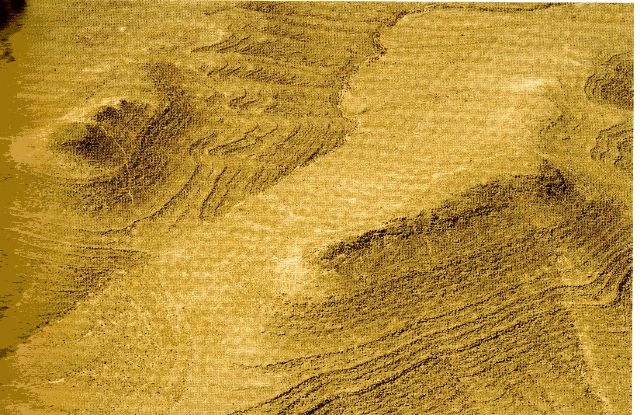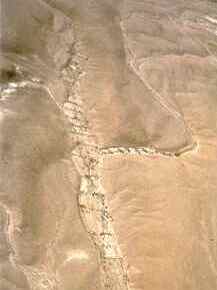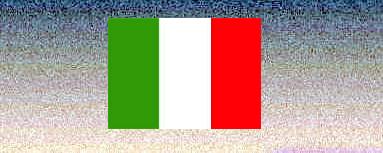HAR KARKOM THE MOUNTAIN OF GOD
Har Karkom is a plateau in the Negev desert, a site surveyed since 1980 by Prof. Emmanuel Anati, who has an archaeological concession in that area. On the base of more than 1200 archaeological sites, Anati claims that Har Karkom is the real Mount Sinai. Flavio Barbiero and his brother Claudio have joined Anati’s research group since 1990 and made a a specific research, aimed to locate the exact position of mount Horeb.In this presentation are briefly exposed the results of this 20 years research. A number of precise correspondences between archaeological sites and written texts prove that the account of Exodus is really historical and that Mount Horeb is in Har Karkom's area.
HAR KARKOM AS MOUNT SINAI

The Christian tradition identifies
the biblical Mount Sinai with the St Catherine massif, on the southern part of Sinai Peninsula. No archaeological evidence prior to the 6th century a.D. has
been found in this area; besides the location and topography of the mountain
does not match with the Bible’s account. For these reasons several scholars
have proposed different locations for the holy mountain, indicated in the
picture on the side.
 On 1982 Prof. Emmanuel Anati, after
a two years survey of Har Karkom, a mountain in the Negev desert, Israel
(circle in the picture above), announced that he had discovered Moses’ Sinai.
On 1982 Prof. Emmanuel Anati, after
a two years survey of Har Karkom, a mountain in the Negev desert, Israel
(circle in the picture above), announced that he had discovered Moses’ Sinai.
Prof. Emmanuel Anati, graduated at Jerusalem University, at Sorbonne in Paris and at Harvard, on 1966 had founded the “Centro Camuno di Studi Preistorici”, in Valcamonica, Italy, an area with a remarkable concentration of rock engravings, spanning for almost ten thousand years. Very soon he became the world’s expert on rock art. On 1980 he obtained an archaeological concession of about 400 sq km at Har Karkom, where he had found a rich complex of rock art.
Very soon he discovered an impressive amount of archaeological evidence indicating that Har Karkom had been a holy mountain since the Palaeolithic and in particular during the Bronze age. Lot of this evidence matches with the biblical account (see, for example, the above picture of Anati, watching a rock engraving that seems to represent the Tables of the Law).
THE HAMMADA, OPEN ARCHIVE OF THE PAST
 Har Karkom is a particular kind of
desert called “hammada”. The main characteristic of this terrain, covered by a
compact layer of small pebbles (see picture aside), is that there isn’t any
process of sedimentation or erosion. The surface has remain unchanged for tens
of thousands of years and maintains in perfect state of conservation the traces
of whoever has put there his tent, or dwelling, in the last 50.000 years or
more.
Har Karkom is a particular kind of
desert called “hammada”. The main characteristic of this terrain, covered by a
compact layer of small pebbles (see picture aside), is that there isn’t any
process of sedimentation or erosion. The surface has remain unchanged for tens
of thousands of years and maintains in perfect state of conservation the traces
of whoever has put there his tent, or dwelling, in the last 50.000 years or
more.
About 200 Palaeolithic villages, covering a period of more than 40.000 years, dot Har Karkom’s plateau. They look as if they had just been abandoned; all of them have provided a huge amount of tools, allowing their precise dating.
See on the following pictures one of such villages, formed by 6 large huts, and an aerial view of a small area where are clearly visible the traces of many huts, together with the Palaeolithic paths (they were kept clean of stones) and the traces of modern cars’ tyres. Thousands of years separate those traces, but there is no mean to establish their age, a part the presence of tools and the shape. Amongst the huts is clearly visible the shape of a large animal, which age cannot be established.


Particularly interesting is a site near the border of Har Karkom’s plateau, where about 30.000 years ago men gathered a huge amount of large stones of silex, with anthropomorphic shapes, forming something like an art gallery (or was it a sanctuary?). Nothing of the kind exists in the rest of the world. It’s a sign that the mountain enjoyed a particular status amongst the palaeolithics.

More than 1.200 archaeological sites have been scheduled so far in the concession of Har Karkom; about 30% of them are Palaeolithic.
THE BRONZE AGE SITES
About 30% of the archaeological sites belong to the Bronze Age Complex (BAC)


More than 2,000 dwelling of different kinds are scattered at the feet of the mountain, most in the Har Karkom valley, but a good many also around it. To the same age belong a lot of other structures, like altars, pillars, platforms, tumulus, tombs, fortresses, and so on. See, for example, a group of platforms at the southern edge of the plateau and a biblical “gal ed” in the valley.


HELLENISTIC AND ROMAN-BYZANTINE SITES
One of the most impressive sites is a large encampment of the Hellenistic age (3d/2nd century b.C.), with about 120 structures (see following picture), aligned in military style. At the border of the camp there are several tombs; but there is a cemetery with 40 tombs of the same age at about 2 km to the north of the camp. This site is important, because it‘s evidence of a large expedition from Palestine in that epoch. A sign that this area was very im portent for them.

Another 30% of the archaeological sites belongs to the Roman-Byzantine age. Most of them are clearly monastic communities (see the following picture: along the wadi a row of huts of the Byzantine period; on the back two large BAC circles). This is also a sign that the area was important from a religious point of view.

ROCK ART
At Har Karkom there are more than 40.000 rock engravings, spanning from the calcolithic to the Islamic age. Most engravings are BAC and represent mainly animals (ibex in particular) and hunting scenes, like the following.


Several engravings are in some way related to the Bible, for example when it says that this is a desert of snake and scorpions. Some reminds God’s eye, or the stick and the snake of Moses


Or nothing less than the tables of the law, like this tablet divided in ten parts, exactly as the rabbinic tradition about the ten commandments.

THE PLAZA SITES
The archaeological sites help to reconstruct the story of this area, and it’s a story amazingly similar to that of the Bible. Most of the BAC villages are in the valley of Har Karkom, but there are almost 40 sites, all responding to the same peculiar outline, that completely encircle the mountain and the villages at its feet. They are the “plaza” sites, so called because they consist of a number of structures enclosing a large circular court.


They are places where cattle was kept, butchered and worked. There were not families in the plazas, only males alone, shepherds of course. Also the tools (no pottery was found there, but a lot of flint) are of the type necessary to work the animals’ skins. The plazas were built around the mountain along the main paths, at a distance of no more than two km from each other, all in view of the previous and following one. They are a clear testimony of the defensive strategy of the people camped at the foot of the mountain. Due to the shortage of pastures, the cattle had to be spread on the largest possible territory, in small groups, easy prey for marauders. Besides, the villages in the valley, with women and children, were stripped of adult males and therefore exposed to assaults from intruders. The system of the plazas solved both this problems. Each group of shepherds was in sight of another two; if one was assaulted the near ones could spread the alarm and intervene in defence. Besides, nobody could penetrate the circle of the plazas without being intercepted.
Finally each group of shepherds could easily provide meat, milk and cheese to their families camped at the foot of the mountain.
BARBIERO’S RESEARCH
Flavio Barbiero, a member of Anati research institute since the years 70s, was aware of Anati’s discoveries and hypothesis since the beginning. Before joining his research group on the terrain, he spent several years in the attempt to understand if the Bible has really an historical content, as the archaeology in Har Karkom seems to indicate. He studied Exodus and Numbers account, finding out that it is a day by day chronicle, very accurate and precise. He wrote a book “La Bibbia senza segreti” (Bible without secrets) explaining his results. For example he has established when, where and how the Jewish have crossed the Red Sea (see following picture: a particular of a nautical map showing a line of shoals that during the lowest tides emerged completely, allowing the passage through the Suez bay). From there to Har Karkom the itinerary of Exodus is easily determined with absolute adherence to the text (Numbers 33).


ARCHAEOLOGICAL EVIDENCE THAT MOUNT HOREB IS IN THE AREA OF HAR KARKOM
MOSES’ TABERNACLE
One of the main results of the preliminary study of Barbiero on the Bible was the faithful reconstruction of Moses Tabernacle, following step by step Exodus description, which is very precise e complete. All the essential data concerning the Tabernacle have been reported in Exodus’ description with such precision that it is possible to reconstruct the forms, the dimensions and the functions of all the components and their exact placing, in the smallest details.
Barbiero has made piece by piece with the exact measures in scale all the items indicated in Exodus, and then put them together. See in the following drawing the plan of Moses’ tabernacle as it results form Exodus’ description, and next the model built by Barbiero.


THE PRINT OF THE TABERNACLE IN HAR KARKOM
The hammada, we have seen, keeps the traces of all tents and structures that were erected there in the last thousands of years. If that was really the place where Moses took the Jews, and if the Bible’s account is historical, was Barbiero’s assumption, there had to be necessarily the print also of the tabernacle, as it is described in Exodus.
According to Exodus 33,7, the Tabernacle was erected “outside the camp, far away from it”. Besides it had to be near the water, that is near the only well of the area: Beer Karkom. So, Barbiero with his brother went up to a hill and looked around for the print. And there it was; they identified it immediately (see following pictures).


They went down and surrounded the print on the ground with a plastic ribbon, following the plan as reconstructed on the base of the account. The match was perfect, down to smallest particular. Even the position of every peg was marked by large stones, well aligned.
At the sunrise and at the sunset the plastic ribbon was shining, therefore drawing the plan of the Tabernacle on the ground with the light; a really fantastic, magic view: an artefact built there more than 3000 years ago was reviving


Thanks to the print on the ground the Barbieros were able to rebuild the tabernacle in its actual dimensions and shape, in exactly the same place where it was built for the first time.


It was even possible to correct some mistakes that inevitably the tentative reconstruction had comported. This is the final plan of the tabernacle as it results from its print on the ground



The major difference is in the dimensions. According to the most common European views, Moses’ cubit measured about 45 cm. With this value the Tabernacle dimensions would have been really excessive for a portable tent, not fit to resist to the desert’s environment. The print on the ground shows a value of Exodus’ cubit of 29,2 cm, as the tent measures 14,60 mt (= 50 cubits) by 29,20 ( = 100 cubits). Therefore the dimensions of the Tabernacle’s furniture (altar, tables, ark etc) have to be revised accordingly.
Conclusions
The shape and other characteristics of the print are such as to let no room for doubts that it was left by the tent described in Exodus, that is by Moses’ Tabernacle. Its value is inestimable not only for historical, archaeological and religious reasons, but also because it demonstrates two things:
1.- that the account of Exodus is based on real facts
2.- that Moses’ holy mountain was in the area of Har Karkom.
MOUNT HOREB
Strong of this result, Barbiero set up to identify with the same grade of reliability the mountain where the events narrated on the Bible took place, that is Mount Horeb. Nowhere on the plateau was it possible to fit those events as narrated in the book, but there was a perfect match with respect to an isolated hill right in the middle of Har Karkom valley (see following picture and map).


The mountain doesn’t have a name, because it is part of Har Karkom’s complex; but it’s a remarkable landmark, perfectly recognizable from miles around. A significant difference with the surrounding territory is that on this mount there isn’t a single rock engraving and there are no structures, except on the top, which is a real “acropolis”: a large monolithic rock, slightly inclined, surrounded by an artificial wall on the northern side, a trench behind the wall, and then an altar and a small group of steles, and a small rectangular temple on the top. The top is covered by natural stones that look like an artificial floor. (see following pictures and the plan of the acropolis).






No doubt at all that this hill was a holy place in the past. The only wadi that descends from the top, widens on a plain at the foot of the hill, from where the northern side of the acropolis is perfectly visible. Right at the centre of the plain there is a big rock, surrounded by several steles. Barbiero named this rock “the altar of the golden calf”, because the environment matches perfectly with the biblical account. Also a stone with a shape like an animal’s head, put against the rock, reminds that episode.


Coming down from the acropolis, just in view of the altar, a flat slab was found, clearly man-made, reminding Moses’ tables. The upper side of the tablet was completely covered by lichens, evidence that it was laying on that spot since several centuries.


Simple coincidences? Too many as to be due to mere chance. These elements, together with several others of that kind, convinced the Barbieros that the isolated hill at the centre of Har Karkom valley has to be identified with the mount Horeb of biblical tradition.
ADDITIONAL EVIDENCE – EGERIA’S ITINERARY
The first Christian to mention mount Horeb is St. Paul. In the epistle to the Galatians (4,25) he says that ”Mount Sinai is in Arabia”. Arabia at that time was the land of Nabateans, which capital was Petra. The second largest nabatean town was Avdat in southern Negev, at only 20 km north to Har Karkom (that was certainly in nabatean territory, as testified by several structures and inscriptions). A great number of villages in Har Karkom valley and on the plateau give evidence that the area was inhabited by a large community of monks during the roman-Byzantine period.
During the fist centuries of the Christian era Har Karkom was recognised by the Christians as the holy mountain of Sinai. Evidence of this fact is provided by the diary of a pilgrim of the 4th century a.D., Aegeria.
Probably a relative of emperor Teodosius, she left Spain on 381 to join Constantinople, but on the way on she visited all the holy places. She left an extraordinarily accurate diary of her visit to Mount Sinai, describing in detail every step of her travel (times, distances and places) and everything she had seen.
Nothing of what she says finds a match on the Saint Catherine. The Barbieros, book on hand, followed faithfully Aegeria’s account at Har Karkom, finding an absolute correspondence, down to smallest detail. At a point that Aegeria’s account can be adopted as the best possible tourist guide of Har Karkom, for what Bible is concerned.
See on the map the itinerary followed by the pilgrim. She spent the first night in a monks’ village on a ridge near Beer Karkom. The following day she went on the main peak of Har Karkom, that she identifies with Mount Sinai. There she attended mass, and then she went on a nearby peak, at the centre of the valley, that she identifies with mount Horeb. On the third day she goes back following the valley and describing whatever she sees along the way. She mentions the altar of the golden calf, villages and even the print of Moses Tabernacle, near the entry of the valley. The match is accurate 100%. Along the path followed the first day (see pictures) there is even a rock engraving, made in Byzantine epoch, that almost certainly celebrates that event. It represent a big personage, mounted on a horse, or mule, with a women’s saddle (the only one in Har Karkom), going up the mountain. Who else, if not Aegeria!




This extraordinary reconstruction gave the Barbieros the certitude that the mountain at the centre of Har Karkom valley was considered to be the real mount Horeb also during the first centuries of the Christian era.
Emmanuel Anati
genesis of a great discovery
 Website and bibliography of Anati on Har Karkom
Website and bibliography of Anati on Har KarkomEGERIA
An ancient Christian pilgrimage to Har Karkom (Mount Sinai)

Mount Sinai’s position according to Christian tradition

The St Katherine monastery at the feet of the homonymous mountain

The main proposed locations for the Biblical Mount Sinai

The cover of Anati’s book revealing the discovery of the real Mount Sinai

The position of Har Karkom and the main tracks crossing the Sinai Peninsula

Har Karkom's profile

The two main tops of Har Karkom’s plateau

Paleolithic huts and paths on Har Karkom’s plateau

Har Karkom’s plateau spotted with Paleolithic villages

A collection of anthropomorphic blocks of flint gathered in a single spot about 30,000 years ago

dwellings of the Bronze age at Har Karkom

A large gal-ed in Karkom Valley

Dwelling of the Bronze age

One of the “plaza site” which surround the mountain and the valley of Har Karkom

Agricultural terracing of roman-byzantine epoch in Karkom Valley

Snakes and scorpions in the Biblical desert

Hunting an ibex on Har Karkom’s plateau
- Back: "Home"
- See: "Bible a historical account "
- Buy a book



